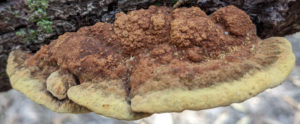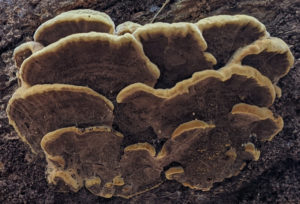
One will stumble on Mustard Yellow Polypores (Phellinus gilvus) outdoors nearly anywhere there is dead wood. This fungus is everywhere, even possibly at the site of our next workshop. It is also known to be supremely medicinal and has been shown to have antioxidant, antimicrobial, anti-cancer, and wound healing properties [see references below].
I was excited to stumble upon log after log full of these mushrooms recently & ended up spending way too much time photographing them. This is how you identify them (I have de-coded the technical words from the identification literature into common language & left the technical words in parenthesis).
One can find Mustard Yellow Polypores growing out of dead logs laying on the ground or on standing, dead trees. They can grow as an individual conk, in groups (gregarious), or in a cluster of overlapping shelves (imbricate). Mustard Yellow Polypores form half moon-shaped (semicircular) shelves with a relatively flat (applanate) surface or they can be slightly convex.
The top surface of this fungus is dark yellowish brown with a mustard-yellow (tawny-olive) colored outer edge (margin) at young and middle age. The whole fungus turns dark brown in old age. Older individuals tend to have concentric (zonate) furrows which are of the same color (concolorous). Mustard Yellow Polypores can appear to have an irregularly lumpy and wrinkled (rugose) surface which is velvety (velutinous) at younger stages & becomes bald (glabrous) when older.
This fungus is broadly attached to the host, therefore it has no stipe (sessile).

Pores on the spore-bearing surface
Underneath, Mustard Yellow Polypores have pores that appear purplish, light brown (ochre) to purplish brown. The round pores are very small and occur 6-8 per millimeter.
The next time you see this mushroom growing, say hello! 🙂
References:
Antioxidant and Antimicrobial Activities of Fruiting Bodies of Phellinus gilvus Collected in Korea. Ki-Nam Yoon, Hyung Seok Jang. Korean J Clin Lab Sci. 2016;48(4):355-364. https://doi.org/10.15324/kjcls.2016.48.4.355 pISSN 1738-3544 eISSN 2288-1662.
Inhibitory effects of polysaccharides isolated from Phellinus gilvus on benzo(a)pyrene-induced forestomach carcinogenesis in mice. Jae-Sung Bae, Kwang-Ho Jang, Hyunee Yim, Seung-Chun Park, Hee-Kyung Jin. World J Gastroenterol 2005;11(4):577-579. World Journal of Gastroenterology ISSN 1007-9327.
Polysaccharides isolated from Phellinus gilvus enhances dermal wound healing in streptozotocin-induced diabetic rats. Jae-Sung Bae, Kwang-Ho Jang, Hee-Kyung Jin. College of Veterinary Medicine, Kyungpook National University, Daegu 702-701, Korea. J. Vet. Sci. (2005), 6(2), 161–164.
Polysaccharides isolated from Phellinus gilvus inhibit melanoma growth in mice. Jae-sung Bae, Kwang-ho Jang, Hyunee Yim, Hee-kyung Jin. Department of Surgery, College of Veterinary Medicine, Kyungpook National University, Daegu 702-701, South Korea. Department of Pathology, Ajou University School of Medicine, Suwon, South Korea. Department of Laboratory Animal Medicine, College of Veterinary Medicine, Kyungpook National University, Daegu 702-701, South Korea. Received 21 June 2004; received in revised form 31 July 2004; accepted 2 August 2004.
Whole-genome sequence of Phellinus gilvus (mulberry Sanghuang) reveals its unique medicinal values. Jinxi Huo, Shi Zhong, Xin Du, Yinglong Cao, Wenqiong Wang, Yuqing Sun, Yu Tian, Jianxun Zhu, Jine Chen, Lijiang Xuan, Chongming Wu, Yougui Li. Journal of Advanced Research 24 (2020) 325–335.
